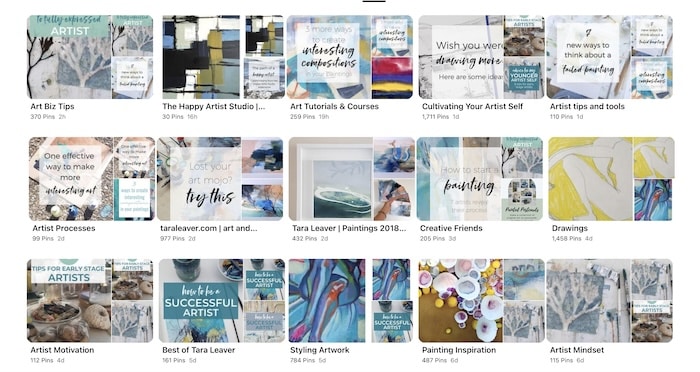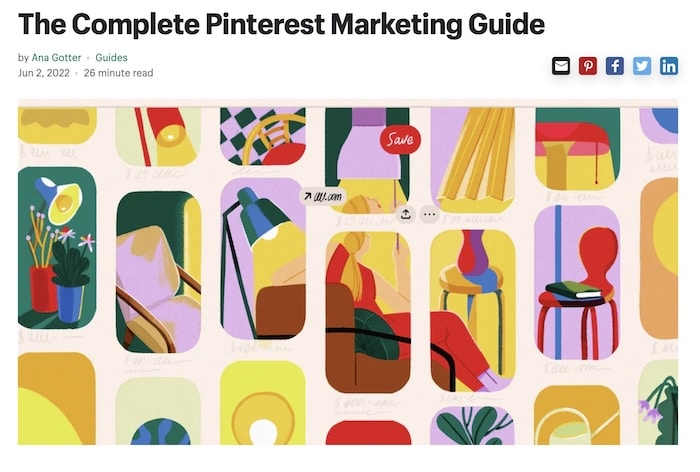Selling art on Pinterest is a strategy yet to be fully explored by many creatives, even with the dominance of social media giants like Instagram and Facebook. While numerous artists utilize Pinterest to illustrate their creative process and promote their work for sale, it stands out as an effective tool for building a following on a platform that isn’t as heavily trafficked as Instagram. So, how exactly does it work, and how can designers and artists optimize Pinterest to garner more attention to their work?
Two artists with significant digital presence embarked on a journey to demystify the platform and better understand how artists use Pinterest. Artist and illustrator Nellie Le from Los Angeles and artist and teacher Tara Leaver from Cornwall in the United Kingdom described their vastly different Pinterest experiences while offering their advice on how to market art on Pinterest to promote your creative practice and navigate through the nuances of selling art on Pinterest.
How Do Artists Use Pinterest?
The key to learning how to master any new platform, including selling art on Pinterest, is to understand its purpose and parameters fully. Launched in 2010, Pinterest is a tool used by many different types of people – not just artists or creatives – to search for, find, and share visual references from the web. It’s a heated point of debate among users whether or not Pinterest should be classified as “social media” since it’s primarily a visual search platform and software rather than a networking site. However, there are social elements to the user experience. On its website, the San Francisco-based tech company brands itself as “the visual discovery engine.”
Tara Leaver, whose creative business consists of painting and selling original work and creating online art courses that help people develop painting techniques and build creative confidence, says in a written interview that she would describe Pinterest as “a search engine that you can organize according to your needs. I like it for building ideas; for example, I might create a board for a specific project or a course idea I’ve had.” This method of organization can be particularly beneficial for selling art on Pinterest by creating boards that showcase available pieces.
Leaver is currently preparing to launch the next session of her online painting course entitled “Abstractify” in July. To help inspire her students and prepare references, she created a Pinterest board of the same name to accompany the course. The board contains pins of various visual references, like colorful landscape oil paintings by masters like Matisse, Chagall, and Hockney, which can also serve as a visual portfolio for potential buyers interested in selling art on Pinterest.

Shopify has a partnership with Pinterest, allowing Nellie Le to sell her art directly on Pinterest without redirecting to her online store.
Nellie Le, an independent artist with a degree in graphic design, describes Pinterest as a “mood board hub.” She has worked for various art and design companies in the past. She says apparel design teams, in particular, use Pinterest as a place to collect and store multiple visual themes – like color and texture inspirations – for their upcoming collections. This visual approach serves design purposes and can be a strategic method for selling art on Pinterest by appealing to visual buyers.
Since pursuing her own art business full-time, though, Le says that she mostly interacts with Pinterest through her Shopify online store, where she sells animal and food-inspired original paintings in hybrid acrylic gouache paint, prints, pins, and stickers, and other handmade items that embody her cute aesthetic. Shopify, an e-commerce platform, has a partnership with Pinterest, allowing Le’s customers to purchase her pinned products directly in the form of “Buyable Pins” without redirecting to her online store.
Pinterest Art 101: Finding and Sharing Your Content
As a creative professional, you will most likely want to open a free Pinterest for Business account, which gives you access to your analytics to know how people interact with your pins, a crucial aspect of selling art on Pinterest.
As you set up your account, here’s a quick vocabulary lesson for the platform:
Pins are rounded corner rectangles that aggregate to make up the Pinterest interface. Pins can be made by any Pinterest user, and they link to the website they are saved from. As an artist, you can make pins from your website, online store, or any site you like. If you like an existing pin you see on Pinterest. You can save it to one of your boards by clicking on the save button in the upper right corner of the pin. If you want more information about a particular pin or want to go to the source website, click on the pin, and it will redirect you.
Pinterest Boards are how Pinterest users can organize their ideas, and they set apart amateur and expert pinners. A user’s board game tells you how well they know how to take advantage of the site. When you save a pin, you choose the board where you want it to appear. You can even subdivide a large board into different sections. You can also share a board with other people or have secret boards that can only be seen by you and whomever else you choose.
You can follow people, topics, or specific boards, and your Home feed shows the pins saved by those you follow. You can look for any image in the search bar by typing keywords or by taking a photo with your device for a visual search.
Leaver says the key to using Pinterest is organization. “There’s a side to me that loves organizing things, so Pinterest really lets me indulge that,” she says. She has 90 different boards that include a dedicated board for posts from her blog, art inspiration boards like “Art Love: Paintings of Water” and “Art Love: Figurative,” a board for her own paintings that are for sale, and boards titled “Creative Encouragement” and “Cultivating Your Artist Self” that contain inspirational quotes.

Leaver has created over 90 Pinterest boards to organize her thoughts, inspirations, and blog articles.
Leaver, who has a staggering 760,000 monthly viewers on her account, reveals how she maintains her weekly Pinterest presence. “Each week, I pin the graphic for my latest blog post to various boards, including group boards – both mine and others I’ve joined. These are a huge help because so many more people see and can repin them. I also pin new work to a couple of boards, both my own and group boards, for selling art on Pinterest. Sometimes, I’ll pin it from my Instagram account, too. While I’m on there, I’ll spend some time pinning to various boards to keep them fresh. I also create a board for every course I offer,” she explains.
Integrating Selling Art on Pinterest into Your Marketing Strategy
Pinterest isn’t necessarily the place where you’ll drive most of your sales as an artist. However, when considering selling art on Pinterest, it can more accurately be conceptualized as an adjunct or supplementary part of your digital art marketing strategy as a creative professional. Pinterest is also useful for artists on a personal level to help stimulate and recall their own creative inspirations, and sharing those inspirations can ultimately pay off.
“You get increased engagement from pinning other people’s stuff [because] it tells a story of you as an artist and shows authenticity for people to see how you’re inspired versus being this machine that just produces art,” says Le, who mostly uses Pinterest to document inspirations for her work rather than as part of a targeted art marketing strategy. Le, who has 57,000 monthly viewers, has boards that echo her creative aesthetic, like “Life Illustrated,” “Cat Lady Things,” “Color,” and “Cuteness.”
Leaver, who first started using Pinterest for her own enjoyment about six years ago, says, “I also have several boards that aren’t necessarily art-related. I’ve always been a huge fan of interior design, so I have some interior and exterior boards, as well as travel boards, recipe boards, and a host of secret boards for personal projects and ideas I’m playing with.” While selling art on Pinterest might not be her primary focus, the platform serves multiple purposes in her creative and personal life.

Shopify has a complete Pinterest marketing guide that may help you promote your art more effectively. (Click the image to get the guide.)
Pinterest Help and Best Practices
As an artist or creative professional, you’re probably bombarded with an array of different digital demands, so you don’t necessarily have to tackle your Pinterest art marketing strategy on your own and build it from the ground up. Instead, you can get some free or low-cost help to maintain your Pinterest presence. For instance, Le says the “Buyable Pins” feature that’s included with her Shopify online shop subscription is a free and low-maintenance cross-pollination tool. Leaver, who took a Pinterest strategy course in 2014 to help build her online business, uses “Boardbooster, a scheduling tool which allows you to automate repins to boards of your choice…[and] helps stop relevant pins being buried on huge boards while keeping everything fresh. [It] offers other tools, such as cleaning boards and checking for broken links.”The company, which is based in Austin, Texas, offers a free trial of up to 500 pins for ten days. Leaver says she pays for the $5 per month plan and finds it to be a good value.
Leaver also gives creatives several concrete tips for getting started on Pinterest:
- Open a Pinterest Business account so that you can use your analytics strategically.
- Do Your Research: “If you’re using [Pinterest] to support your business, create boards that align with that and that allows you to cross pin to different boards. Look at what others with large followings in your field are doing with their accounts and how they set their boards up.”
- Learn some basic graphic design skills so that you can make simple and attractive pins. If you aren’t adept with Photoshop, Leaver recommends a simple graphic tool like Canva.
- Pin Consistently: “Especially at the beginning, pin as often as possible, or use a tool like Boardbooster. It doesn’t have to take up a lot of time – just 15 minutes a day will help it grow. Join a few group boards in your field. And have some secret boards that don’t necessarily fit with your brand just for your own fun.”
At the end of the day, everyone’s creative business is different, and figuring out how to maximize a digital art marketing strategy can be a trial-and-error process that continues to shift with constantly changing technologies. Says Le: “How I run my business is different from how a ceramicist or a weaver runs their business…Everyone’s business is different because every artist is different…[but] every artist will tell you that it’s a perpetual learning experience…We hope people like [what we create], we see what sticks, and keep going with it.”
For more on social media Marketing, see 8 Ways to Attract Art Collectors to Your Instagram.
Have you used Pinterest to market your creative brand or work? Tell us in the comments below!
